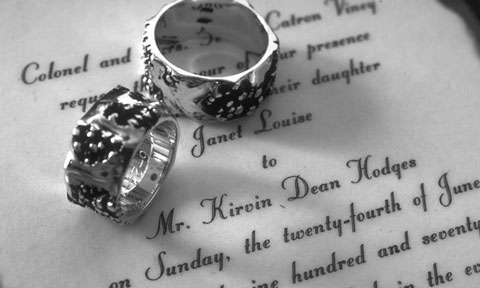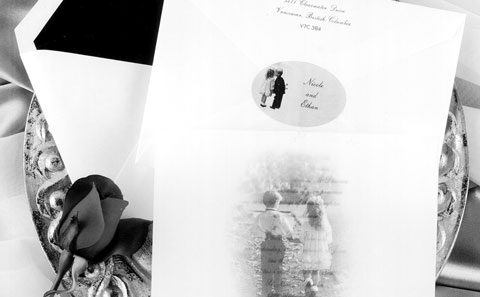Invitations & Inviting
The Art of Inviting
The wedding invitation has taken on much more meaning than simply telling people where and when to be there. If that’s all it was, a simple phone call might do. You’ll find as you investigate the options available, that you can spend a little or a lot on this part of your wedding.
The traditional sizes for invitations are embassy 5.5″ x 7.5″ and classic 4.5″ x 6.75″ both of which can be sent by regular mail but there are now a lot of alternative sizes available. Multiple or unusual folds and a wide range of decorative elements has required more space and different dimensions.
There are numerous sources for invitations, including commercial printers that were the first, and still print invitations. Other sources to check are stationery suppliers, card shops and Internet outlets or catalogue houses. The latter offer some of the best pricing and greatest selection but you will be purchasing based upon a picture rather than an actual sample making it difficult to get a sense of the “feel” of the paper – important if you are selecting a textured paper.
The most common means of selecting is by perusing sample books put out by some of the big producers such as Art Craft. These catalogues contain up to 100 various samples and are updated periodically.
The following is a short list of the things to consider when purchasing this type of invitation.
- Folds – two-part, three-part from top,
- left side or meeting in the middle.
- Paper type – from smooth finishes like
silk to heavily textured. - Overall size and format – vertical or
horizontal. - Ink colour – black, blue, green burgundy or the more expensive silver or gold.
- Typeface used for lettering – some
suppliers offer more than two-dozen. - Raised or standard flat lettering.
- Paper colour – usually off-white or
pastel shades. - One envelope or two.
- Lined or unlined envelopes.
- Surface decoration such as bells,
flowers, you name it. This includes embossing, gold and silver and pearlized.
There are alternatives to this type of invitation, each of which has advantages and drawbacks.
Custom, one-offs created by an artist or
craftsperson
If you are looking for something original, this is the way to go, especially if the number of people being invited is small. Expect a relatively high cost because each is hand-produced. These invitations can also act as a keepsake for friends and family inclined to value such things. This is where you can get into specialty papers with embedded flowers, ribbon and gold threads as well as hand colouring and lettering.
Do it yourself on the computer.
Few people can due this successfully because they lack the necessary design skills and the results offered by most home-use printers do not come close to commercial-level printing. You will be much more limited in the paper type because home-use printers do not handle heavy or textured stock. If you add up the time involved, you are probably better to us a simple form card and enter the particulars such as the date and location by hand.
Commercially-printed.
Most print shops can produce invitations but offer fewer selections of paper, colour and special touches such as embossing and raised inks. The price is about the same for a similar catalogue style unless you are printing 200 or more.
Here’s how the business side works.
Catalogue orders
Expect to pay a deposit or the whole amount of the order in advance. After all, there is nothing they can do with them if you cancel or change your mind. The turn-around time is about 2-3 weeks from the date you place the order.
Invitations are not cheap; ranging from a low of about $4.00 a piece up to, hold your breath, over $30.00 each. Price is greatly affected by the style and options you choose. You’ll pay extra for everything from unusual layouts, ink colour and paper. The most common quantities are 75 and a 100 – there is a very small difference between the price of 25 (the minimum) and 100.
For Commercially-printed
Most printers can complete these jobs in a couple of weeks and will probably ask for a deposit if they don’t already do business with you. If you are selecting an unusual paper, allow more time as it will need to be ordered. The same guidelines apply in regards to cost and quantity – 500 aren’t going to cost a lot more than 50. Although some printers do not do this type of work and are unable to create the effects of embossed lettering on conventional presses, they may be willing to come up with a few ideas of their own. However, custom jobs usually have a higher cost.
Considerations
The following are some of the things to consider before you place your order.
How many do you need?
When determining the number of invitations required, remember you are only sending one per couple, which can significantly reduce what’s required. That said, order some extras because some may get lost and need to be resent and some people may be unable to attend making room for someone else to be invited. You will also want to keep a few extras for nostalgia purposes.
When do you order?
Invitations should be ordered no less than three months before the date and sent eight to twelve weeks in advance. Allow more time if you are inviting people from foreign countries. It will usually require no less than two weeks to get replies. The sooner you know who is coming the easier it is to plan items such as the reception and notify the caterers of how many people they will be feeding.
Photographic invitations
These are a recent innovation incorporating a picture of the couple, commonly taken for the engagement announcement. If you choose this option you will be more limited to the type of paper you can use in order that the picture is printed clearly. Some catalogue services offer this option for a few layouts in either colour or black-and-white. Alternatively a photo can simply be included with the invitation. Digital printing can reduce the cost of these prints and provide an equivalent result.
Do’s and Don’ts
Read the proof copy of the
invitation very carefully. It’s amazing how easily you can read over a misspelling of your own name or an incorrect address. Try reading it upside down or reflected in a mirror. Most printers will require you to “sign-off” on a proof copy so if an error shows up after printing you still must pay for them.
You may think you can just “whip some up” on your home computer but resist the thought. Although it is definitely a cheap way to do it, few people have the right design skills or the printing equipment to create them properly. If you insist on doing it this way, you may want to design it yourself and send it to a print house for production.
Avoid do-it-yourself touches
such as glitter paint, adhesive stick-on or fall-out inserts. These additions tend to have the reverse effect to what you expected.
Hand-lettered invitations by a
skilled calligrapher are expensive if done in quantity. Rather than spend money on this service, consider using a nicer paper, gold lettering or other touches.
Unless you are extremely good at it, don’t attempt to do your own calligraphy. It takes considerable time and the paper you may waste may cost more than what you save.
If envelopes are addressed by
hand, get someone with a good writing style – rough or illegible addresses will detract from the rest of the invitation.
If the wedding is in an out-of-
town location or not easily found, be sure to include a small map, which can be commercially printed or photocopied. In any case, it should be consistent with the rest of the invitation and explain what it is i.e., “Directions to St.Thomas United Church”.
Address labels should be avoid
ed if possible. If required, consider transparent labels.
Motif elements such as ornamental borders, floral designs and stylized images can be incorporated into the overall design but are there as accents only.
If the wedding has a “theme”
colour, consider a paper stock or ink colour that reflects this.
If you are expecting guests to
dress a special way, state this in the invitation.
Address envelopes to unmarried
couples individually i.e., Mr. James Smith & Ms. Leslie Galway.
Make sure that foreign guest scan read the invitation. You may be sending them to your mother’s European relatives for whom English is not their first language.
If the ceremony is at one location and the reception at another, include both addresses.
Who to Invite
Before you can determine how many invitations are required, you need to decide who is being invited. This will be a combination of the bride’s list, the groom’s list and those of the parents. The decision process requires a great deal of sensitivity. Excluding a family member can create problems that will last for years. It also requires close attention to the budget. The wedding should not create a financial burden requiring years to repay.
One approach is to work from the smallest group out. This would include the members of the wedding party on each side, the parents of bride and the parents of the groom. The next logical addition, are the siblings of the bride and groom. After that come the grandparents, the aunts and uncles and important friends.
An alternative approach is for each of you to develop your own lists, with a specified number of family members and friends. It works well if the immediate families are of a similar size as a balance is easily reached.
Regardless of how you do it, one side of the family may be larger than the other. If you are on the short side, don’t think that you have to round out the numbers by inviting people to balance the tables. It’s also good to remember that the wedding is not the time to return an earlier invitation or satisfy an outstanding social commitment. That said, he who pays the piper gets to call the tune so if parents are paying a substantial amount of the wedding cost you may need to acquiesce when they insist on inviting a family member or friend that you are not fond of or may not know.
The more notice you are able to provide, the more likely that everyone you invite will be able to attend. However, there is usually a small number that will not be able to make it. In these cases, simply send them your regrets and take it in stride.
Wording Guidelines
There are standards as to how invitations should be worded so as not to offend anyone and handle almost every type of situation. Most printers or retailers selling invitations can offer you a comprehensive guide. Here are some of the most common.
Standard
Mr. And Mrs. Henry James Jones
Request the pleasure of your company
At the marriage of their daughter
Marie Jane
to
Mr. Edward Robert Smith
Wednesday the thirteenth of April
At five o’clock
At the home of
Mr. And Mrs. Lewis Smith
Clinton Ontario
The bride issues her own invitations
The honor of your presence is requested
At the marriage of
Miss Mary Lane Stephenson
to
Doctor Jeffrey WIlliam Durance
Bride and groom issue own invitations
The honor of your presence is requested
At the marriage of
Miss Betty Ann Jones
to
Mr. William Robert Marlow
Mother and stepfather – Bride’s father deceased.
Mr. and Mrs. Everett Bond Kingston
Request the honor of your
presence
At the marriage of their daughter
Edie-Marie Brown
Mother or father deceased and surviving parent has NOT remarried
Mrs. Charles Lee Stoner
Requests the honor of your
presence
At the marriage of her daughter
Margaret Ann









